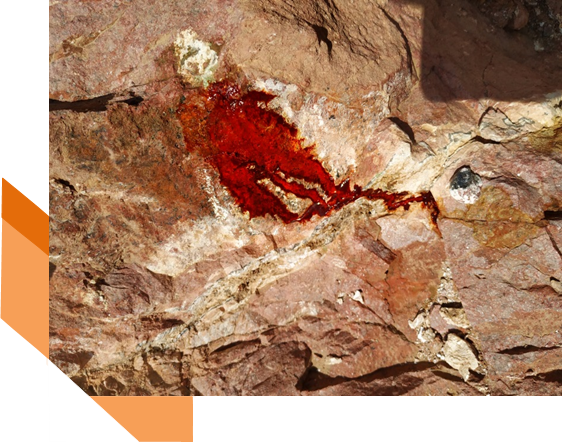Exploration
![]() Sampling
Sampling
Far too often small operators, in a mistaken attempt to reduce costs, conduct little or no sampling before beginning to mine. Probably the first thing one needs to determine is what the goal of your sampling program is.
Using poorly planned sampling methods is a technique guaranteed to give poor results. When beginning a sampling project, it’s important to plan what you are doing in advance. When designing a sampling program the first thing that has to be considered is: What are you trying to determine? Are you exploring for new deposits or trying to characterize the average grade of a known vein or other deposit?
The goals of a prospecting or exploration sampling program are not the same as the goals in ore characterization sampling.
In prospecting or exploration, one is looking for ore deposits concentrations of mineralization that would be worthy of further investigation. In an exploration project, the miner is looking to find new ore bodies, paystreaks or patches of nuggets. The goal in this type of operation is to identify likely locations for deposits and prospect there to see if some valuable deposits can be found.
In sampling, one is taking a more or less known deposit and testing it to characterize the extent and grade of the deposit, determine its size, typical grade, and other characteristics. This is usually done when considering a commercial mining operation in order to make an economic analysis or feasibility study to determine if it is economic to mine that deposit. It is important to recognize that most of the gravel in many placer mines is waste (the same is true for vein rock in most hard rock mines). When you are prospecting, you are searching for the valuable parts of those deposits, while in sampling, you are deciding the typical grade and size what is ore and what is not.

![]()
Abilities and properties
Abilities:
-
Designing a variety of sampling networks for different exploration purposes
- Sampling in metallic and non-metallic mines
- Types of groove sampling, full lips, waterway and so on
- Chemical analysis and mineralogy of samples
- Analysis of chemical analysis results
Properties:
-
A team of search and sampling specialists
- The best and most accurate laboratories for chemical analysis of materials
![]() Ongoing-projects
Ongoing-projects
-
There is currently no project in progress.
![]() Experience
Experience
-
Biazeh lead and zinc mine in Isfahan province
-
Chapan polymetal exploration area (copper, gold and iron) in Kurdistan province
-
Exploration area of Chromite and Magnesite in Manojan, Kerman province
-
Prospecting of copper, gold and iron indices in an area of 29,000 square kilometers in Kurdistan province
-
Darb Behesht (Ramun) Polymetal mine in South Kerman province
-
Ghaledar Kuhpayeh exploration area in Isfahan province
-
Shahrab Ardestan exploration area in Isfahan province
-
Hashem Abad Nain exploration area in Isfahan province
-
Balazard Gold mine in South Khorasan province
-
Dehsalm Poly-metal mine in South Khorasan Province
-
Exploration of Farid limestone range in an area of 21 square kilometers in Qom province
-
Khusf Polymetal exploration area in South Khorasan province
-
Prospecting of Iraj Copper exploration area in Isfahan province
-
Prospecting of Kolah Barfi Iron exploration area in Isfahan province
-
Prospecting of metal deposits in an area of 280,000 square kilometers in Isfahan province
-
Prospecting of copper index in the area of 8000 square kilometers in Isfahan province
-
Qaen copper mining area of South Khorasan province
-
Prospecting of mineral indices in the Balu and Bagham areas of 20 square kilometers of Isfahan province
-
Prospecting of metal deposits in an area of 2500 square kilometers in Isfahan province
-
Prospecting and Exploration of Nehbandan Traonyx mine in South Khorasan province
-
Tejareh marble mine of Isfahan province
- Ardestan Copper and Iron mine in Isfahan province
-
Khondab and Emarat lead and zinc areas in Markazi province
-
Chekrizeh Copper mine in Kerman Province
- Khoogan Lead and Zinc mine in Markazi Province
-
Hormozgan Cement mines in Hormozgan province
-
Chupanan Polymetal mine in Isfahan province
-
Bafgh Iron Ore mine in Yazd province
-
Kharanagh Iron Ore mine in Yazd province
- Soheil Iron Ore mine in Isfahan Province
-
Eshrat Abad Iron Ore mine in Isfahan province
-
Oshnaviyeh Iron Ore mine in West Azarbaijan province
-
Siriz Iron Ore mine in Kerman province
-
Bafgh Iron Ore mine(Next to Sechahoon) in Yazd Province
- Jahad-Abad Shale mine in Isfahan Provine
-
Dehbid Bowanat iron ore mine in Fars province


